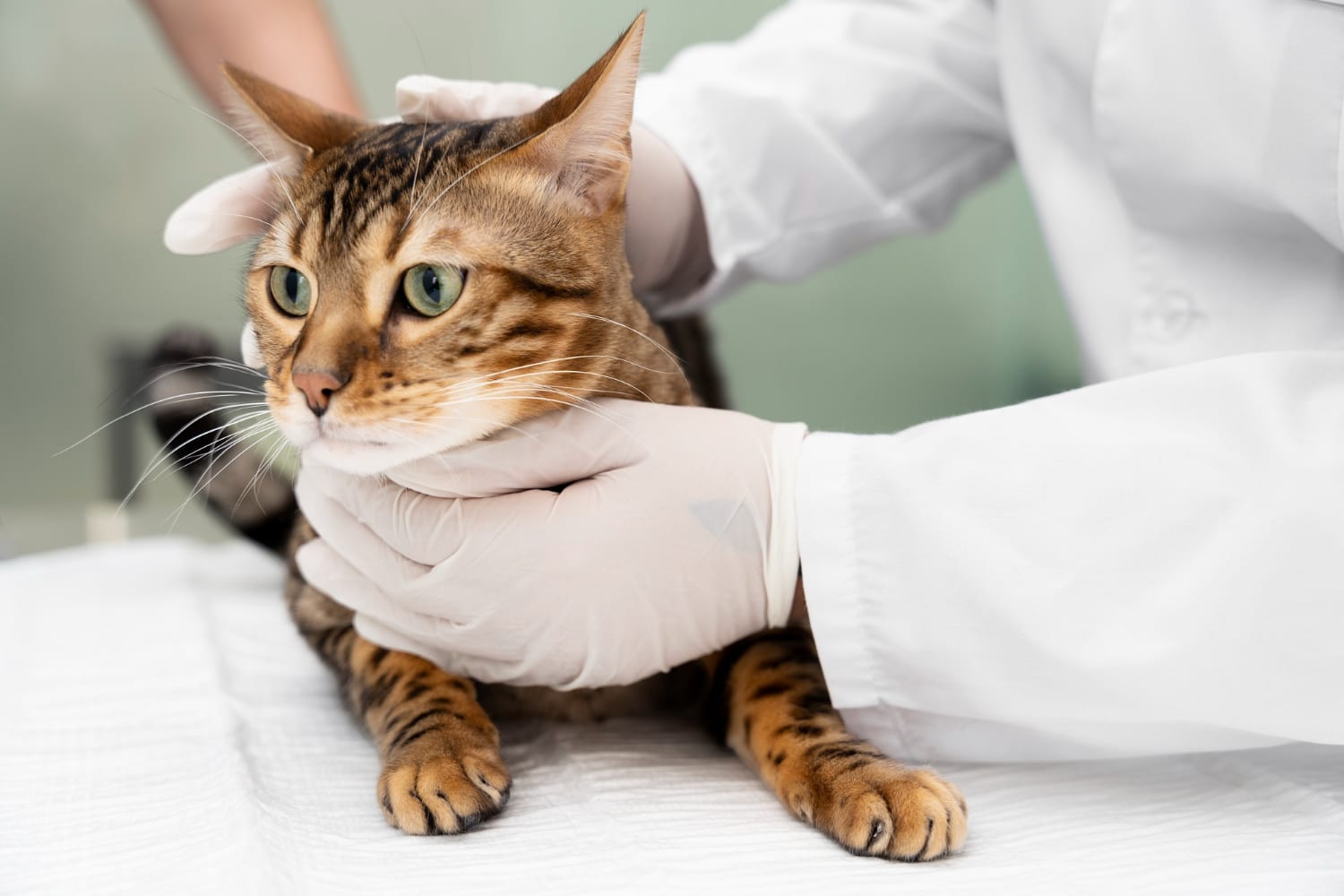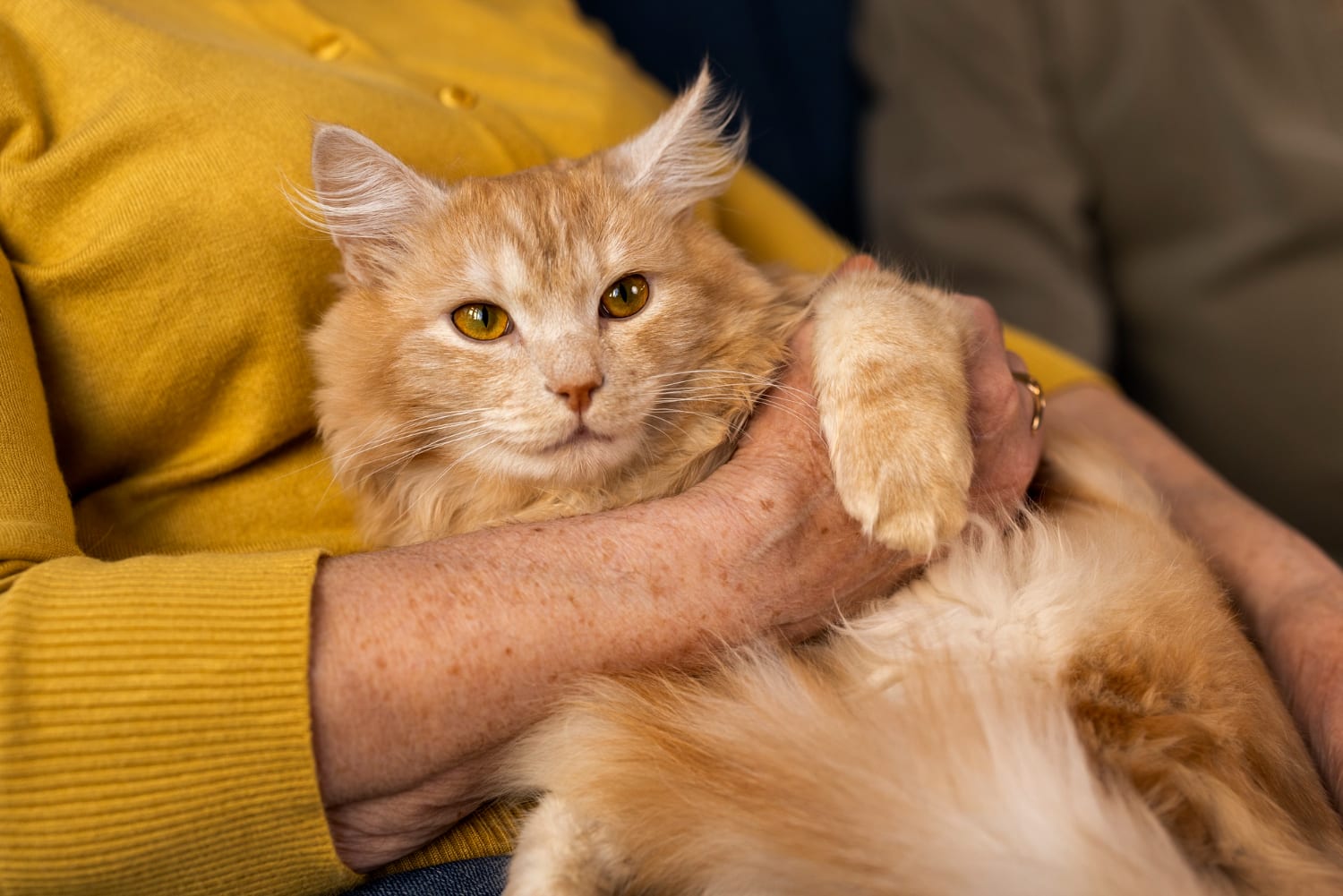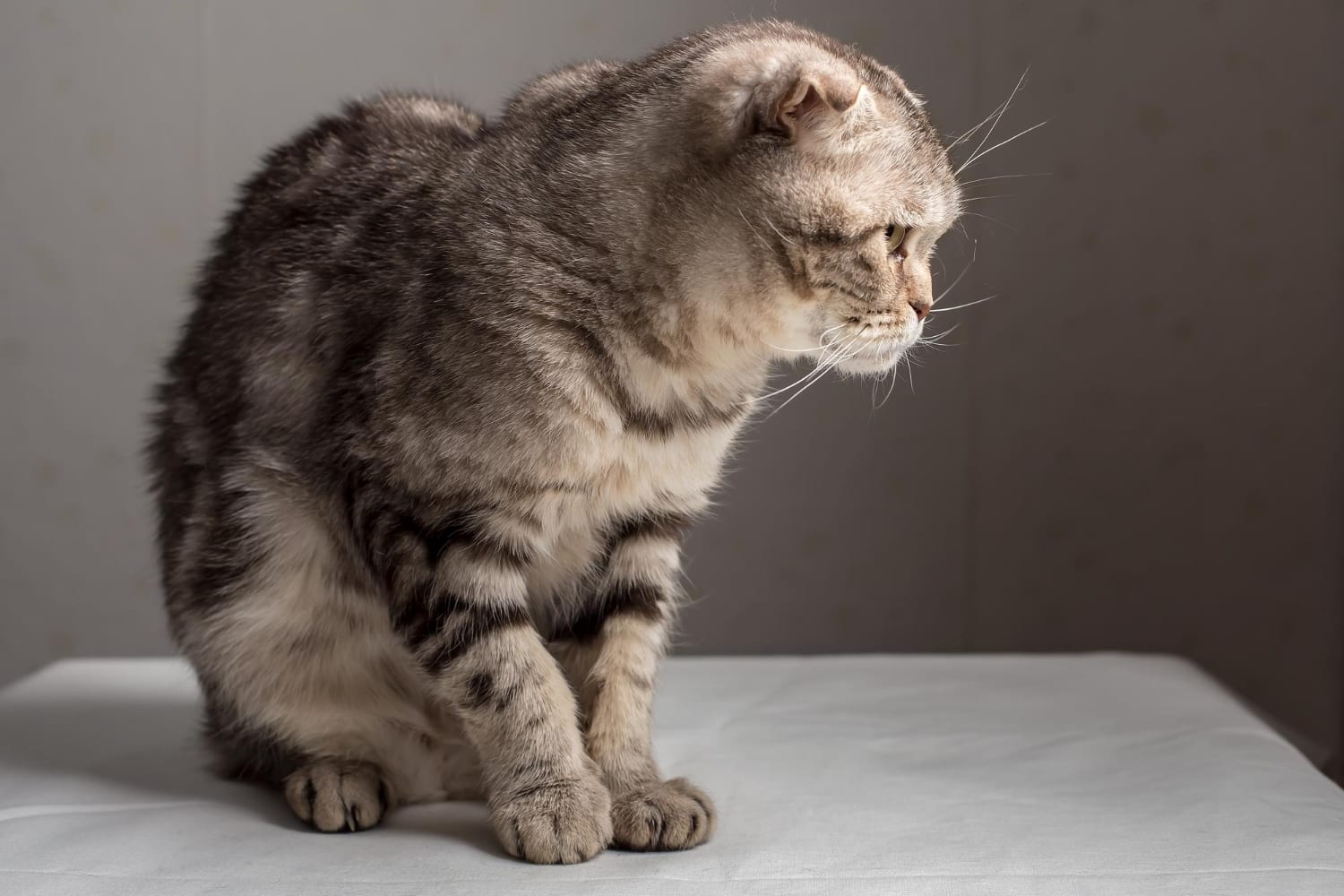Feline Cystitis in Cats: What You Need to Know

By Evelyn Harcourt
June 03, 2025 - 1 min read
Feline Idiopathic Cystitis (FIC) is a form of Feline Lower Urinary Tract Disease (FLUTD). It is the most common type, which we frequently see in practice. For many cats, there is no specific cause, and it is thought that stress plays an essential role in its development.
This article explores how to recognise when your cat has cystitis (bladder inflammation), how to manage it, and how to prevent future episodes.
What is Feline Cystitis in Cats?
Feline cystitis describes an inflamed bladder. Inflammation can be triggered by stones, masses, and infections.
For many cats, however, there will be no obvious inciting cause. We use the term ‘idiopathic’ cystitis to refer to cases of unknown origin.
The Role of the Urinary Bladder
The bladder is a storage vessel that keeps urine inside the body after the kidneys have filtered it and before it is passed out through the urethra.
Urine stored within the bladder can form crystals, especially if it is very concentrated and has been in there for a long time. This is more likely to happen when the urine contains a lot of minerals, when the cat is dehydrated, and when the pH (acidity) is too high or too low.
Difference Between Cystitis and UTIs
Many owners assume cystitis is the same as a Urinary Tract Infection (UTI). In fact, studies have shown that less than 3% of cats with cystitis will have a bacterial urinary infection. Generally, cats over 10 will have bacterial infections, as the likelihood increases with age.

Signs and Symptoms of Cystitis in Cats
The signs of cystitis can be subtle, at least in the initial stage. They can be confused with ‘bad behaviour’, especially when cats urinate outside their litter tray or act more grumpy.
Common Behavioural Changes
Cats who have cystitis are uncomfortable, and this can be reflected in how they behave. You may notice they are spending less time being active and are less social. Conversely, some cats will become restless and may act more clingy. Affected cats also tend to groom more, particularly around their belly and genitals.
You may notice your cat spending more time in its litter tray and passing urine in smaller quantities but more frequently than it usually would. The urine is sometimes passed outside of the tray, in places such as the bath or your bed.
Your cat may be less keen on you touching it, particularly over its belly. Some cats may become more temperamental or even aggressive.
Physical Symptoms to Watch For
Some of the more common physical symptoms of feline cystitis include:
- Urinating more often
- Straining to pass urine
- Genital licking
- Excessive thirst
- A reduced appetite
- Being vocal when passing urine
- Blood or cloudiness in the urine
- Stronger-smelling urine
How It Differs From Other Urinary Issues
Cystitis is a sterile condition, meaning there is no bacterial involvement. It is the bladder lining that is inflamed. Cystitis is deemed ' idiopathic cystitis ' when there is no apparent cause, such as urinary stones or a bladder mass.
Cystitis is a disease of younger and middle-aged cats, while conditions such as bladder cancer, kidney disease, and urinary infections tend to affect seniors.
Another consideration is that cystitis tends to be a recurrent problem, with flare-ups during times of stress or a changed routine.

Causes of Feline Cystitis
Determining the cause is essential for developing a treatment plan and preventing future episodes. However, pinpointing the cause can be tricky in some patients, as, for many, there is no obvious trigger.
Idiopathic Cystitis (FIC)
Around two-thirds of cases are ‘idiopathic’, meaning no underlying issue can be identified. It is widely believed that cats with FIC have a damaged GAG (Glycosaminoglycan) layer of their bladder wall and more pain receptors and fibres.
Stress-Related Factors
Stress can trigger and worsen cystitis. In cats, stress can be physical, chemical, or emotional, and it can disrupt their everyday life or routine.
Some common examples include the adoption of a new cat, a house move, an owner going away on holiday, or an abrupt diet change. Even the weather becoming colder can trigger more sensitive cats.
Certainly, inter-cat relations are very significant when it comes to FIC, and it is those cats who share their territory with other cats who are most often affected.
Urinary Tract Infections
As mentioned above, UTIs are an uncommon cause of cystitis and are only a factor for about one cat in 30. Infections are usually seen in senior cats and tend to be associated with underlying issues such as bladder masses or diabetes.
Bladder Stones or Crystals
Crystals are common in cystitis patients, as bladder inflammation can lead to their formation. Struvite is the most common crystal type in cats, and it tends to occur in urine that is too alkaline and concentrated.
Over time, crystals can accumulate, and stones can form. These stones have the potential to cause urinary obstructions, chronic pain, and infection.

Diagnosing Cystitis
If your cat presents with the classic symptoms, your vet will be suspicious of cystitis and will run a number of tests to determine why it is happening.
What Your Vet Will Look For
Your vet will check your cat over and assess for any underlying issues, such as dehydration, obesity, or joint pain. They will also palpate (feel) the bladder and kidneys, assessing for any changes in size or discomfort.
Diagnostic Tests
A urine sample should be assessed, and the presence of blood, bacteria, or crystals should be checked. This may be a sample that the vet expresses during the consult, or your vet may request that you go home to collect a sample, using a special non-absorbent cat litter.
When the vet wants to culture the urine to check for any bacteria present, they should use a small needle to collect the sample directly from the bladder (cystocentesis). Blood tests may be run to assess for clinical signs of dehydration, infection, general inflammation or kidney disease.
Your vet might also consider some imaging, such as an X-ray to check for certain stone types and a bladder scan to further assess the kidneys and bladder in more detail. Imaging can check for the presence of any bladder ‘sludge’ (crystals) or physical masses.
Treatment Options
The main aim of cystitis is to reduce stress and inflammation, as well as to ensure the cat does not become physically obstructed (blocked). If you’re concerned that your cat cannot pass urine, you must call an emergency vet immediately.
Pain Relief and Anti-Inflammatories
Those with cystitis are inevitably uncomfortable and require pain relief. As the bladder wall is inflamed, they’ll also need medicine to target this. Most vets use a non-steroidal anti-inflammatory (NSAID) called Meloxicam for this purpose.
In addition, some cats may need stronger pain relief options (such as Gabapentin or Buprenorphine) if they are in great discomfort.
In the long term, your cat may be issued bladder supplements to fortify the GAG layer and reduce inflammation in the bladder wall.
Dietary Management
When crystals are identified or the urinary pH is abnormal, your vet may discuss a diet change. Prescription diets that target the crystals or stones present can stabilise the urinary pH.
When a prescribed diet is issued, this should be fed exclusively and should not be changed without veterinary guidance.
For most, wet diets are the better choice. They help improve hydration levels and make the urine less concentrated, which means crystals and stones are less likely to develop.
Stress Reduction Techniques
It is not always easy to reduce stress in a cat’s life, particularly when we are unsure what is upsetting them.
To reduce stress in general, it helps to:
- Provide plenty of physical and mental enrichment
- Have plenty of hiding spots within the home for your cat to sleep
- In multi-cat households, to ensure the cats do not have to share any of their resources (including litter trays, water bowls and scratching posts)
- Offer daily calming supplements
- Use pheromone products, such as a Feliway plug-in
- Provide plenty of litter trays, and keep them clean

Preventing Future Episodes
Owners need to work hard to prevent future episodes of cystitis, as those who have had one episode are much more prone to them.
Litter Boxes
Litter boxes must always be clean and inviting. A cat is unlikely to use their box if it is dirty or in a busy spot, and they will then hold their urine, leading to crystal formation and bladder inflammation.
There should be a minimum of 1.5 trays per cat. This means two trays in a home with one cat and three trays in a home with two cats. Place the trays where there is little foot traffic, not near each other or any food or water sources.
Environmental Enrichment
Enrichment is key to stress reduction. This can be provided through exercise opportunities, food puzzles, cat trees, scratch posts, interactive toys, etc.
Other lovely ideas include cat TV or radio, cat balconies, or perches by the windowsill where the cat can look out. When an option, allowing your cat to go outdoors, is another excellent form of enrichment.
Proper Hydration
Providing a moist or wet diet is one good way to improve hydration, but we also ideally want our cat to be drinking regularly.
Cats typically prefer freshly caught rain water to tap water, as the taste of the chemicals in tap water can be off-putting. Similarly, they dislike stagnant water, so they prefer water fountains over water bowls.
For those cats who dislike drinking water, you can add it to their meals or offer them regular cat soups and broths.
Top Tip: In the wild, cats would not drink water near food sources if there was contamination. For this reason, do not have their water bowls near their food bowl (or their litter tray).
When to See a Vet
If your cat is showing signs of cystitis, they need to be evaluated by a vet. At a minimum, they will need some anti-inflammatories, and perhaps also some bladder supplements and a diet change.
Your vet will want to ensure there are no underlying issues, such as stones or an infection.
Learn More About Feline Cystitis in Cats
We see many cases of feline cystitis every year and are always happy to talk through things in more detail with you.
Contact us if you think your cat may be experiencing an episode of cystitis or if it’s prone to episodes and you want to discuss this in more detail.
Feline Cystitis FAQs
Is Feline Cystitis Dangerous?
Cystitis tends to resolve within 3-5 days and, while unpleasant, is not inherently dangerous for your kitty. The exception is when it progresses to a urinary blockage. This is when the cat is physically unable to pass urine, a complication seen more often in males. Signs can include constant straining, lethargy, food refusal, crying, and vomiting.
Can It Go Away on Its Own?
Yes, some episodes will resolve within a few days without any intervention. However, providing therapy (such as pain relief and anti-inflammatories) is preferable to help keep your cat comfortable and reduce the risk of developing a urinary obstruction.
How Can I Help My Cat at Home?
From home, it helps to keep stress levels low and hydration levels up. This can include keeping the home calm and quiet, providing mental enrichment and a moisture-rich diet.
Continue reading

Signs a Cat is in Pain and How to Recognise Them
Learn how to recognise pain in your cat and the subtle signs to look out for.
Read article
What to Do If Your Dog Eats Chocolate?
Learn what to do if your dog eats chocolate and the signs of toxicity to look out for.
Read article
Signs of Hypothermia in a Dog and How to Treat It
Learn the signs of dog hypothermia and how to treat it quickly and safely.
Read article